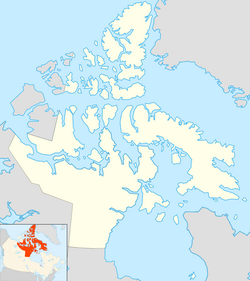Eureka, Nunavut
| Eureka | |
|---|---|
| Settlement | |

Eureka seen from its airfield
|
|
| Coordinates: 79°59′20″N 085°56′27″W / 79.98889°N 85.94083°WCoordinates: 79°59′20″N 085°56′27″W / 79.98889°N 85.94083°W | |
| Country | Canada |
| Territory | Nunavut |
| Region | Qikiqtaaluk Region |
| Island group | Queen Elizabeth Islands |
| Founded | April 11, 1947 |
| Elevation | 83 m (272 ft) |
| Population | |
| • Total | 8 |
| Time zone | EST (UTC−05:00) |
| Postal code | X0A 0G0 |
| Area code(s) | 613 |
| Population consists of 6 MSC staff and 2 contracted employees Elevation is at Eureka Aerodrome. | |
Eureka is a small research base on Fosheim Peninsula, Ellesmere Island, Qikiqtaaluk Region, in the Canadian territory of Nunavut. It is located on the north side of Slidre Fiord, which enters Eureka Sound farther west. It is the third-northernmost permanent research community in the world. The only two farther north are Alert, which is also on Ellesmere Island, and Nord, in Greenland. Eureka has the lowest average annual temperature and the lowest amount of precipitation of any weather station in Canada.
Eureka's postal code is X0A 0G0 and the area code is 613.
The base consists of three areas:
PEARL is operated by a consortium of Canadian university researchers and government agencies known as the Canadian Network for Detection of Atmospheric Change. PEARL announced it would cease full-time year-round operation as of April 30, 2012, due to lack of funding, but this decision was reversed in May 2013 with the announcement of new funds.
Eureka was founded on April 11, 1947, as part of a requirement to set up a network of Arctic weather stations. On this date, 100 tonnes (98 long tons; 110 short tons) of supplies were airlifted to a promising spot on Ellesmere Island, and five prefabricated Jamesway huts were constructed. Regular weather observations began on January 1, 1948. The station has expanded over the years. At its peak, in the 1970s, at least fifteen staff were on site; in 2005, it reported a permanent population of zero with at least 8 staff on a continuous rotational basis.
Several generations of buildings have been developed. The latest operations centre, with work areas and staff quarters in one large structure, was completed in 2005.
Eureka experiences a Polar climate (ET). The settlement sees the midnight sun between April 10 and August 29, with no sunlight at all between mid-October and late February. Eureka has the lowest average annual temperature and least precipitation of any weather station in Canada with an annual mean temperature of −18.8 °C (−1.8 °F). However, summers are slightly warmer than at other places in the Canadian Arctic due to the fact that Eureka is somewhat landlocked, being near the center of Ellesmere Island. Even so, since record keeping began, the temperature has never exceeded 20.9 °C (69.6 °F), first reached on July 14, 2009. Although a polar desert, evaporation is also very low, which allows the limited moisture to be made available for plants and wildlife.
...
Wikipedia

